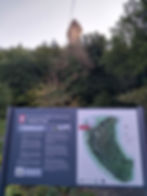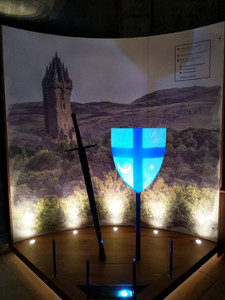The National Wallace Monument: Honouring a Scottish Hero
- Wee Walking Tours
- Oct 23, 2020
- 6 min read
Updated: Apr 6
The Stirling landscape is steeped in history. In fact, one of the most famous battles in all Scottish history took place there- led by the iconic William Wallace. This week we climb to dazzling heights to learn about the Scottish hero, and the monument built in his honour. So, slip on some comfortable shoes and join us as we venture to the Scottish countryside for some incredible history and views.

William Wallace- ‘Guardian of Scotland’
The National Wallace Monument is about a 45-minute drive from Edinburgh and is a magnificent tower nestled in the woods of the Abbey Craig. It was built in honour of William Wallace- the man affectionately known as ‘Braveheart’. Wallace was an incredible ‘Guardian of Scotland’ and played an integral role in the battle against England for Scotland’s independence. Perhaps one of his most famous battles was the Battle of Stirling Bridge in 1297.

We will revisit this historic story in more detail in a future blog post. However, for now I will summarise the story by explaining that Wallace- along with Andrew de Moray- were fighting against the invading English army (sent by Edward I).
Edward had invaded Scotland and set up English administrators to try to take over. Furthermore, he was trying to defeat the Scots at Stirling Bridge as it was the gateway to the north of Scotland.
Wallace and Moray defeated the invading English soldiers at Stirling Bridge, and the battle helped to give the Scots confidence to continue to resist and fight for their independence. A fight that would later be taken up by another iconic Scot- Robert the Bruce.
Unfortunately, Wallace was eventually captured in 1305 and handed over to Edward in London. Edward charged him with high treason (which was ridiculous because Wallace had not pledged loyalty to him as he was an invading English king in Scotland). Wallace was found guilty during his ‘trial’ and, Edward had him brutally executed.
Wallace was gruesomely drawn and quartered. His head was put on a pike for all to see on London Bridge. The quarters of his body were put on display in Newcastle, Berwick, Perth, and- in a particularly cruel and disgusting gesture- Stirling Bridge.
Both Wallace’s acts of bravery and his horrific execution by an English king contributed to his legend and place in history as a Scottish martyr. Through oral tradition, he was recognised through the centuries as a hero. However, Scots eventually realised the need for a physical monument to help cement the memory of the man into the national collective memory.
Remembering Wallace
In the 1800s, monuments to honour those who had passed were de rigueur. So how did they come up with the beautiful design we see today? Well, like another iconic Scottish memorial structure- the Scott Monument- the building committee decided to have an architectural competition. They eventually chose an entry that had been anonymously signed, “nothing on earth remains but fame”.

The architect who had submitted the anonymous entry was J.T. Rochead. He was known for building in the Baronial style (among others), but it was his design suggestion of putting a Scottish imperial crown on the top of a castle-like tower that really helped him to win the competition. Prior to this, only churches had such a feature (one of the most famous is St Giles’).
The site on the Abbey Craig was chosen for practical purposes as they could quarry the stone nearby. It was also deemed appropriate as it overlooked Stirling Bridge and paid homage to Wallace’s famous battle. The foundation stone for the National Wallace Monument was laid in 1861. A great deal of drama unfolded surrounding the building of the monument, but I’ll save that story for when you visit the Monument. Essentially, there was much wrangling over costs and money.
Nevertheless, the Monument was completed in 1869 and was a success as people happily visited the tower. However, there was criticism of the architecture by other architects and the general public (isn’t there always?!). Regardless, over time, the initial criticism has given way to recognition of the National Wallace Monument as a magnificent building that enhances the landscape.
A Virtual Visit
Our virtual journey starts at the Visitor Reception Centre. Located next to the carpark, this is where you will find the entrance, public toilets, a gift shop, and Legends Coffee House- a perfect place to fortify your climb up to and within the Monument or to refuel after.
Visiting the National Wallace Monument encompasses more than climbing up the lovely tower. There are a series of marked nature trails and woodland walks on the Abbey Craig. The trail up to the Monument is marked and takes about 15-20 minutes. However, if you would prefer, they also offer a minibus courtesy service that picks up visitors at the Visitor Reception Centre and takes you directly to the Monument.


The tower is 67 metres tall and requires us to climb 246 steps to reach the top! Don’t worry, we will pace ourselves and take wee breaks at the galleries we encounter on our ascent. Think of visiting the Monument (and all of Scotland for that matter) as your very own health and well-being plan. With that in mind, let’s get to it.

The first staircase we encounter is straight and provides a dramatic entrance to our climb. Looking up at the high ceiling, there are two banners welcoming us. Eventually we get to the staircase turret and this is where our winding climb takes over. Fortunately, as it is a nice autumn day, I appreciate the fresh breeze blowing in through the open arrow slits. Perhaps I would feel differently if it were winter. My heart is starting to beat quite fast, and I’m grateful we have come to the first gallery so I can stop and catch my breath.

This gallery is known as the ‘The Hall of Arms’ and tells the story of William Wallace. The highlight of the room is the Wallace Sword. The sword (which was previously located at Dumbarton Castle) is magnificent, and it is not hard to see why it holds its place as a national symbol of Wallace’s strength and determination.
Also, in this room, they have “the only surviving document which was issued by Wallace and which bears his seal.” The informational board outlines how it was written after Wallace’s and Moray’s success at Stirling Bridge. “In the letter they tell the merchants of Lübeck in Germany that they can safely come to Scotland to trade”.
After enjoying the wee exhibition section and film on Wallace, we continue our trek upward and onward. Our next stop is ‘The Hall of Heroes’ where they honour famous men and women from Scottish history. Notably, they have busts of Robert Burns, John Knox, and, of course, Robert the Bruce.
The final gallery we come to is ‘The Royal Chamber’. Here, you can see what the landscape looked like during Wallace’s day as well as design your own shield.
All of this is quite fascinating, but we must continue and make our way up to one of the best parts of the National Wallace Monument- the Crown Spire!

The views from the Crown Spire are simply stunning. The landscape has certainly changed quite a bit since 1297. Looking out in the distance (to the top right of the picture below), you can see the magnificent Stirling Castle.

Be sure to hold tight to your phone when you take pictures because the wind is incredibly gusty up here! In fact, I think it’s time for us to head back down to the ground level to check out the wee gift shop.

While only assistance dogs are allowed in the Monument, I am happy to say that all dogs are allowed on the Abbey Craig. Finn and Sawyer had a wonderful time exploring the woods and checking out the various wooden sculptures that can be found along the trail that leads up to the Monument. Even though they weren’t allowed inside the Monument, they still had fun modelling around outside.
I hope you have enjoyed your virtual visit to the National Wallace Monument. However, we highly recommend a visit in person so that you can experience its majesty and breathtaking views for yourself. Please keep in mind that, as of this writing, reservations must be made online in advance. Therefore, visit their website so that you find the most up to date information and can plan accordingly.
After you take in Stirling’s splendour, be sure to head over to our exquisite capital city- Edinburgh. You can continue your health and well-being plan by exploring Edinburgh on a walking tour with us. We love to lead visitors around the city which boasts its own spectacular views and stunning monuments.
Until next time- Explore & Discover!
*Update*
Please note that, since this blog post was written, our beloved Sawyer and Finn are no longer with us and have crossed over the Rainbow Bridge. However, we continue our blog and tours in their memory.























